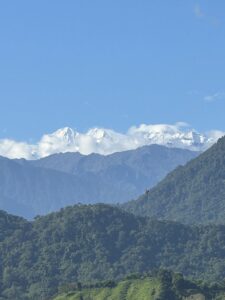Lost City Santa Marta Colombia is an indigenous city built by the Tayrona Culture in the 7th and 8th centuries AD, 650 years before Machu Picchu in Peru. It is located in the Sierra Nevada de Santa Marta in the department of Magdalena, Colombia.
It is also known as:
Lost City is composed of a network of villages around the Lost City we know today, which is considered the center of operations. It was a place where political, economic, religious, and spiritual aspects were managed. In short, it was a metropolis in the middle of the Caribbean jungle, next to the highest snowy peaks in Colombia.
The main feature of the Lost City is its terraced platforms, which were built to allow agriculture on mountainous terrain. These terraces were designed to maximize water retention and the cultivation of various agricultural products such as corn, beans, and yucca. In addition to agriculture, the Tayrona people also practiced hunting, fishing, and the collection of wild fruits and plants.
The Lost City also housed ceremonial and religious structures such as temples and plazas. These structures reflect the importance of religion and spirituality in the lives of the Tayrona people. Priests played a crucial role in society and were responsible for conducting rituals and offerings to maintain the balance between the natural and supernatural worlds.

It is said that in the year 1650, the indigenous community abandoned the city because they did not want it to be discovered and destroyed by the colonizers. As time passed, the Lost City was abandoned and remained hidden under the jungle for centuries. However, its discovery in the 1970s drew the world’s attention and it became an important archaeological site. Since then, excavations have been carried out, and numerous objects such as ceramics, tools, and jewelry have been found, providing valuable clues about the Tayrona culture.
The city was discovered in 1972 by a group of Colombian explorers led by American archaeologist Richard Evans Schultes. However, it is believed that the indigenous people of the region were already aware of the existence of the Lost City from previous generations. The city was covered by the rainforest and could only be accessed through a series of staircases and steep paths.
Frank Rey, known as “el abuelo”, a renowned looter, visited the archaeological site several times in secret with other looters, and it is believed that some of them took pieces of great importance to the Tayrona Culture that are still missing.
Articles of interest: Las máscaras perdidas del pueblo Kogui vuelven a su origen en la Sierra Nevada de Santa Marta
Later, in 1976, Gilberto Cadavid and Luisa Fernanda Herrera, along with others, initiated the first expedition with the guidance of Franky Rey, “el abuelo”, a well-known looter from the region. It is said that after 12 days of expedition, they managed to reach the site and collect archaeological samples and evidence, which were presented to the then-president Alfonso Antonio Lázaro López Michelsen to approve the budget for the recovery of the archaeological zone, as it was buried and covered by the rainforest.
Then, in late 1979, Margarita Serje, an anthropologist from the University of the Andes, together with the Institute of Anthropology and the University of the Andes, among others, established the “Cultura Tayrona” foundation to finance the research with a group of 7 researchers that lasted until 1983. From that point, the management was handed over to the Colombian Institute of Anthropology and History (ICANH).
After significant investment and a massive team effort, it was opened to the public in 2005.
It is worth noting that in 1986, Lost City of Santa Marta was declared a Biosphere Reserve and World Heritage Site by UNESCO.
What is the Lost City of Santa Marta composed of?
Who manages the Lost City of Santa Marta?
The Lost City has been the subject of significant preservation and conservation efforts. Currently, access to the city is controlled, and obtaining a permit and joining a guided tour is required to explore it. This is done to protect the archaeological site and prevent potential damage caused by uncontrolled tourist activity.
The Lost City of Santa Marta has become a popular tourist destination in Colombia. Visitors can undertake multi-day hikes through the jungle to reach the archaeological site. During the journey, they have the opportunity to appreciate the rich biodiversity of the Sierra Nevada de Santa Marta and learn about the Tayrona culture through the explanations of the guides.
As an archaeological park, it is administered by the Colombian Institute of Anthropology and History (ICANH). People who visit it are required to make a contribution to the local communities, farmers, and indigenous people. The Lost City can be visited throughout the year on private and community tours that last from 3 to 6 days and are operated by one of the 7 authorized tourism agencies, including Ecosierra Pérdida Tours SAS BIC
These are the available excursions, tours, or travel packages to the Lost City of Santa Marta:
The Lost City of Santa Marta, also known as Teyuna, is a fascinating archaeological site that offers a window into the past of the Tayrona civilization. With its ingenious architecture, religious significance, and integration with nature, the Lost City represents a valuable historical and cultural legacy. Through its preservation and controlled exploration, we can continue to uncover the mysteries hidden among its terraces and pathways, and appreciate the richness and greatness of the history of the Santa Marta region in Colombia.
Recommend article: What is included and what is not included in the tour to the Lost City of Santa Marta?
Sources:
V-blog
Testimonials


Ut enim ad minim veniam, quis nostrud exercitation ullamco laboris nisi ut aliquip ex ea commodo consequat. Duis aute irure dolor in reprehenderit in